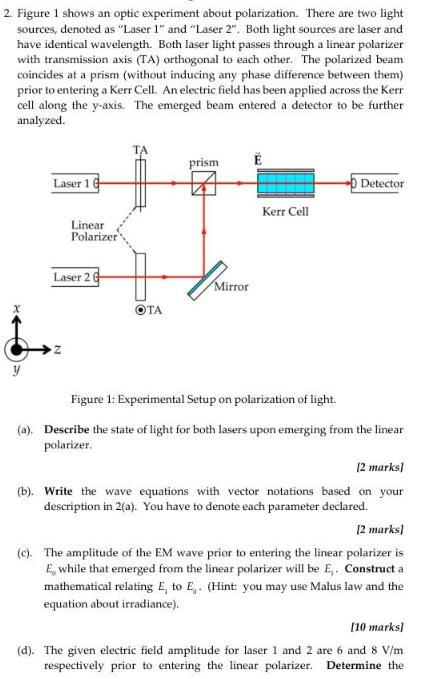Answered step by step
Verified Expert Solution
Question
1 Approved Answer
2. Figure 1 shows an optic experiment about polarization. There are two light sources, denoted as Laser 1 and Laser 2. Both light sources

2. Figure 1 shows an optic experiment about polarization. There are two light sources, denoted as "Laser 1" and "Laser 2". Both light sources are laser and have identical wavelength. Both laser light passes through a linear polarizer with transmission axis (TA) orthogonal to each other. The polarized beam coincides at a prism (without inducing any phase difference between them) prior to entering a Kerr Cell. An electric field has been applied across the Kerr cell along the y-axis. The emerged beam entered a detector to be further analyzed. Laser 16 Linear Polarizer Laser 20 OTA prism Mirror Kerr Cell Detector Figure 1: Experimental Setup on polarization of light. (a). Describe the state of light for both lasers upon emerging from the linear polarizer. [2 marks] (b). Write the wave equations with vector notations based on your description in 2(a). You have to denote each parameter declared. [2 marks] (c). The amplitude of the EM wave prior to entering the linear polarizer is E, while that emerged from the linear polarizer will be E. Construct a mathematical relating E, to E. (Hint: you may use Malus law and the equation about irradiance). [10 marks] (d). The given electric field amplitude for laser 1 and 2 are 6 and 8 V/m respectively prior to entering the linear polarizer. Determine the
Step by Step Solution
There are 3 Steps involved in it
Step: 1
Solutions Step 1 Answer State of Light after Emerging from the Linear Polarizer The linear polarizer ...
Get Instant Access to Expert-Tailored Solutions
See step-by-step solutions with expert insights and AI powered tools for academic success
Step: 2

Step: 3

Ace Your Homework with AI
Get the answers you need in no time with our AI-driven, step-by-step assistance
Get Started


